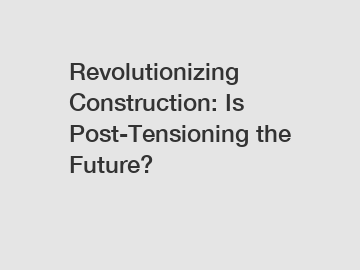Revolutionizing Construction: Is Post-Tensioning the Future?
Revolutionizing Construction: Is Post-Tensioning the Future?
Post-tensioning techniques in construction have grown significantly in popularity over the past few decades. This innovative method involves applying tension to steel cables after pouring concrete, resulting in increased structural strength and durability. In answer to the question, "Is post-tensioning the future?", the answer is a resounding yes. This article will delve into the origins of post-tensioning, discuss the process of its implementation, and highlight the significant impact it has on the construction industry.
Origins and Evolution of Post-Tensioning.

Post-tensioning was first introduced in the early 20th century but gained substantial momentum during the 1950s. Initially, it was primarily used in large-scale infrastructure projects, such as bridges and highways. However, with advancements in technology and the recognition of its numerous advantages, post-tensioning has now found its way into commercial and residential construction as well.
The Process of Post-Tensioning.
Post-tensioning involves the use of high-strength steel cables or bars that are threaded through ducts within the concrete structure. These cables are tensioned to a specified load once the concrete has partially hardened. This process creates a compressive force in the concrete, minimizing internal cracks and enhancing resistance to external forces.
The tensioned cables transfer the load to anchorages that are strategically placed throughout the structure. These anchorages are designed to distribute the load evenly, ensuring optimal stability and structural integrity. Post-tensioning also allows for flexibility in design, as the cables can be placed in different patterns, enabling architects to create unique and striking structures.
The Significance and Impact.
Post-tensioning has revolutionized the construction industry in various ways. Firstly, it allows for the construction of longer and more slender spans, reducing the need for additional support structures. This translates to cost savings, as fewer materials and labor are required.
Another significant advantage is increased durability. By applying post-tensioning, structures gain resistance against the effects of shrinkage, temperature changes, and loading. The technique also enhances seismic resistance, making buildings more resilient to earthquakes and other natural disasters.
Furthermore, post-tensioning enables faster construction and reduces maintenance requirements. The technique allows for faster curing of concrete, speeding up the construction process. This, combined with the elimination of joints and the reduced occurrence of cracks, results in reduced maintenance costs and a longer lifespan for the structure.
In conclusion, post-tensioning has emerged as a game-changer in the construction industry. Its origins trace back decades ago, and its evolution has led to widespread adoption in various types of construction projects. The process itself involves applying tension to steel cables, which enhances structural strength and durability. With its numerous benefits, including cost savings, increased durability, improved seismic resistance, and faster construction, it is crystal clear that post-tensioning is indeed the future of construction. As technology continues to advance, this technique will play an ever-increasing role in shaping the buildings of tomorrow.
Are you interested in learning more about threaded rebar price, 20mm threaded rebar manufacturer, rock bolts hot rolled thread bar? Contact us today to secure an expert consultation!

Comments